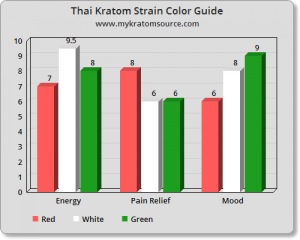Kratom: Spotlight on the Thai Strain
Let's talk kratom. Whatever your opinion may be on this natural botanical, it's origins and historical uses remain an interesting subject. Today, lets look at the Thai strain:
Thailand is a native home of the kratom tree, where it is known as Kakuam or Ithang. It has been cultivated and harvested by the local population for thousands of years, as kratom trees grow fruitfully in the south of the country. Kratom leaves have been used in folk medicine as a natural mood enhancer, pain reliever, energy lift without over-stimulation, diarrhea treatment and many other common ailments.

Along with the extreme popularity among manual laborers and truck drivers who would take it for an energy boost instead of energy drinks (which can cause over-stimulation and anxiety), kratom has been used in Thailand to effectively treat opium withdrawal.
Interestingly, kratom has an intimate connection with the history of opium, which is abundant in Thailand. When individuals were addicted to opium, they would often substitute it with the much safer kratom leaf, which provided milder effects and relieved withdrawal symptoms. This provided a way for people to wean themselves off their addiction to opium by slowly taking less and less kratom every day.
It is rumored that this relationship between kratom and opium caused Thailand to pass the Kratom Act 2846, in 1943. You see, the use of Mitragyna Speciosa (kratom) continued to grow, and it cut into the Thailand government’s highly lucrative taxes on opium traders and shops. As more people turned to kratom, a much less expensive option than opium, the government started to see declining tax revenues, prompting the kratom ban.
This Act made kratom and its alkaloids a controlled and scheduled substance within Thailand. Possession of the herbal product was made illegal and the law demanded that no new kratom trees could be planted, and all existing trees were to be cut down and destroyed so that no new leaves could be harvested. However, enforcement of this law was not very effective since the tree is naturally indigenous to the region. Many traditional populations, especially in the south of the nation are rumored to continue to grow and use kratom.

Thai kratom is well-known for its powerful energetic effects. The unique alkaloid profile of Thai kratom often produces different reactions between different users, and may not be for everyone. However, this strain has a very dedicated following.
Reports of the pain-killing effects of Thai seem to be variable; typically, Red Thai is an effective choice in regards to analgesia and energy, whereas white and green Thai strains are said to be stimulating and a great choice for depression, but may be lacking in pain relief.
True Thai-grown kratom is impossible to come by due to it being illegal in Thailand, so all “Thai” kratom is grown elsewhere no matter what some vendors would like to state. That being said, Thai strains that you find on the market today are grown near Thailand. Thai and Malay kratom seem to be very similar - which makes sense, given the geographical proximity of each other. The same goes with the strain found on Sumatra, cut off from Malaysia and Thailand by only the narrow Straits of Malacca.
To explore kratom more, please visit the MKS Ultimate Kratom Guide.
WARNING: In the U.S., kratom is sold strictly as an exfoliating and/or research botanical only. Consuming kratom has many interactions and negative consequences cautioned by the FDA. All information relating to the pharmacological effects of kratom is NOT intended to promote consumption and is for educational purposes only.